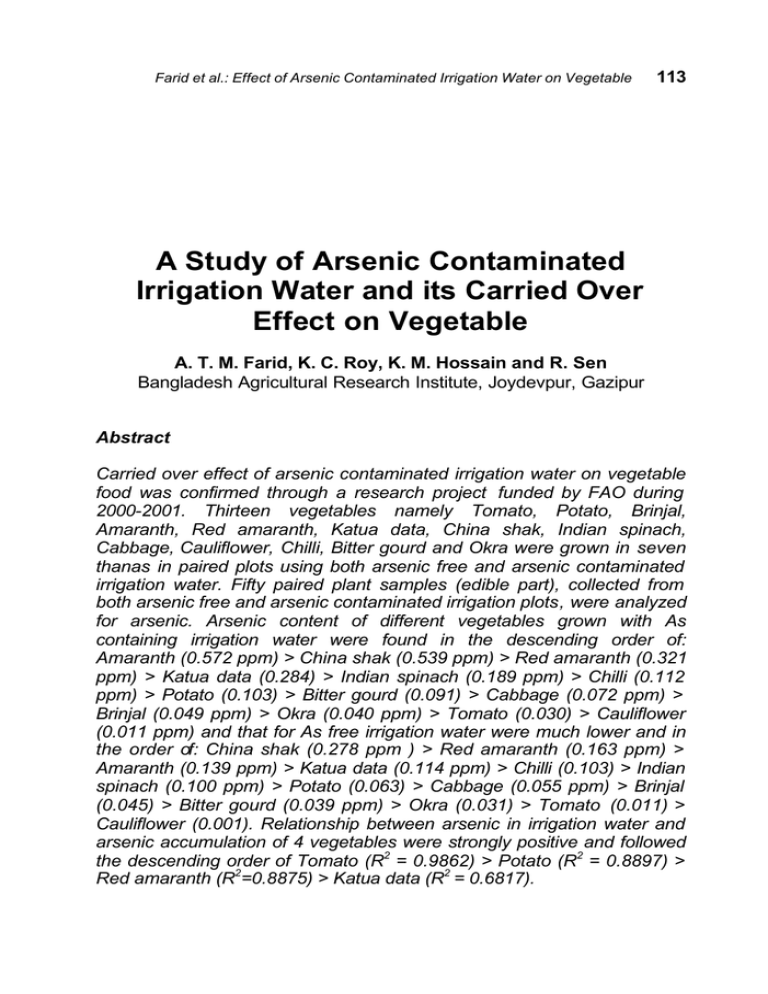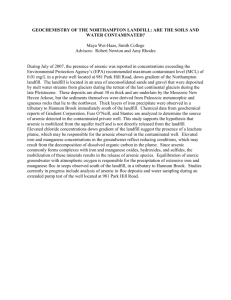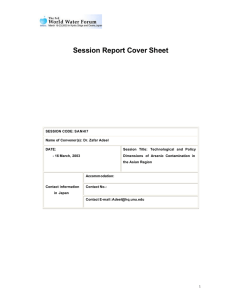A Study of Arsenic Contaminated Irrigation Water and its Carried Over
advertisement

Farid et al.: Effect of Arsenic Contaminated Irrigation Water on Vegetable 113 A Study of Arsenic Contaminated Irrigation Water and its Carried Over Effect on Vegetable A. T. M. Farid, K. C. Roy, K. M. Hossain and R. Sen Bangladesh Agricultural Research Institute, Joydevpur, Gazipur Abstract Carried over effect of arsenic contaminated irrigation water on vegetable food was confirmed through a research project funded by FAO during 2000-2001. Thirteen vegetables namely Tomato, Potato, Brinjal, Amaranth, Red amaranth, Katua data, China shak, Indian spinach, Cabbage, Cauliflower, Chilli, Bitter gourd and Okra were grown in seven thanas in paired plots using both arsenic free and arsenic contaminated irrigation water. Fifty paired plant samples (edible part), collected from both arsenic free and arsenic contaminated irrigation plots, were analyzed for arsenic. Arsenic content of different vegetables grown with As containing irrigation water were found in the descending order of: Amaranth (0.572 ppm) > China shak (0.539 ppm) > Red amaranth (0.321 ppm) > Katua data (0.284) > Indian spinach (0.189 ppm) > Chilli (0.112 ppm) > Potato (0.103) > Bitter gourd (0.091) > Cabbage (0.072 ppm) > Brinjal (0.049 ppm) > Okra (0.040 ppm) > Tomato (0.030) > Cauliflower (0.011 ppm) and that for As free irrigation water were much lower and in the order of: China shak (0.278 ppm ) > Red amaranth (0.163 ppm) > Amaranth (0.139 ppm) > Katua data (0.114 ppm) > Chilli (0.103) > Indian spinach (0.100 ppm) > Potato (0.063) > Cabbage (0.055 ppm) > Brinjal (0.045) > Bitter gourd (0.039 ppm) > Okra (0.031) > Tomato (0.011) > Cauliflower (0.001). Relationship between arsenic in irrigation water and arsenic accumulation of 4 vegetables were strongly positive and followed the descending order of Tomato (R2 = 0.9862) > Potato (R2 = 0.8897) > Red amaranth (R2=0.8875) > Katua data (R2 = 0.6817). 114 Fate of Arsenic in the Environment INTRODUCTION Water is the next important input to fertilizer for crop production. If water is polluted, it may be dangerous for plants, animals as well as for human being. About 33 percent of total arable land of our country is now under irrigation facilities (BBS, 1996). Most of the above mentioned lands are irrigated with groundwater which comes from deep tube well, shallow tube well and hand tube well. Most groundwater used for irrigation in Bangladesh are contaminated with arsenic (Khan et al., 1998). If arsenic contaminated water is used for irrigation, it may create hazard both in soil environment and in crop quality. Twenty percent loss of crop (cereal) production due to high concentration (20 ppm) of arsenic in plant body was reported by Davis et al. (1998). Like other heavy metals, arsenic is toxic to plant (Martin et al., 1993) and its discharge into the environment must be carefully controlled and minimized. Vegetables are important food crops of Bangladesh and are rich in vitamins and minerals which are very essential for maintaining good health. Most of the vegetables contain more than 80 percent water. Therefore, it is of utmost importance to determine the arsenic content in vegetables. Very limited work has been done on the effects of using arsenic contaminated water on crop production and it's carried over effect on food chain. With this view in mind, this study was undertaken to find out the level of arsenic transmission from irrigation water to vegetable food. MATERIALS AND METHODS Field experiments were conducted on 13 vegetables namely Tomato, Potato, Brinjal, Amaranth, Red amaranth, Katua data, China shak, Indian spinach, Cabbage, Cauliflower, Chilli, Bitter gourd and Okra grown in 7 thanas viz. Gopalgonj sadar, Muksedpur, Monirampur, Pirgachha, Rajarhat, Chapai Nawabgonj Sadar, Charghat in paired plots using both arsenic free and arsenic contaminated irrigation water. Twenty one experiments in all with randomized complete block design replicated four times were conducted by 5 NGOs. Polythene was used in between two plots to protect horizontal movement of arsenic from arsenic contaminated irrigated plot to arsenic free irrigated plot. Vegetables were harvested and packed with labeled polythene/brown paper. These labeled packed vegetables were immediately sent to BARI soil laboratory and divided into different pieces with knife. Precautions were taken so that arsenic could not transfer from one sample to another through knife. Farid et al.: Effect of Arsenic Contaminated Irrigation Water on Vegetable 115 Labeled and chopped plant parts were kept in the sun for one or two days for removing moisture. After sun dry, the samples were taken in labeled brown paper and kept in oven at 800C for 72 hours. The dried plant samples were grinded by a electrical grinder. After grinding one sample, the grinder was cleaned so that arsenic could not transfer from one sample to another. The grinded samples were immediately sent to Analytical Laboratory where arsenic was determined with Atomic Absorption Spectrophotometer (HG-AAS) following USEPA method 1632. RESULTS AND DISCUSSION Arsenic content of soil and water of the experimental sites are given in the Tables 1 and 2. The summary results of arsenic content of different vegetables grown by both arsenic free and contaminated irrigation water are presented in Table 3. The graphical presentation of relative arsenic content of different vegetable is shown in Figure 1. Arsenic content in different vegetables varied widely. There was spatial variation also. Spatial variation in irrigation water in the study sites was well established by BGS (1999). For easy understanding, crop wise data are described in this paper. Table 1: Status of arsenic in experimental soil Place Gopalganj Sadar Mukshidpur Monirampur Pirghacha Rajarhat Chapi Nawaganj Sadar Charghat Range (ppm) 0.261 to 7.035 0.303 to 8.628 0.690 to 4.960 1.200 to 8.100 0.200 to 5.500 1.980 to 7.480 0.200 to 40.080 No. of Sample 132 86 70 90 90 78 220 Table 2: Status of arsenic in experimental irrigation water Place Gopalganj Sadar Mukshidpur Monirampur Pirghacha Rajarhat Chapi Nawaganj Sadar Charghat Range (ppb) 150 to 791 129 to 532 247 to 765 134 to 667 112 to 490 59 to 796 158 to 689 No. of Sample 132 86 70 90 90 78 220 116 Fate of Arsenic in the Environment Table 3: Arsenic contents of different plant samples Tamato Potato Brinjal Lalshak Bitter gourd Amaranth Katua data China shak Cabbage Indian Spinach Cauli flower Chilli Okra Location Nawabgonj Monirampur Gopalgonj sadar Pirgacha Rajarhat Nawabgonj Monirampur Gopalgonj Nawabgonj Pirgacha Monirampur Charghat Monirampur Pirgacha Muksed pur Monirampur Monirampur Muksed pur Muksed pur Gopal gonj Charghat Arsenic content (ppm) Contaminated Uncontaminated No. of Sample Crop Range Mean Range Mean 3 2 2 .016-.049 .013-.021 .211-.390 0.030 0.017 0.301 .001-.025 .001-.014 .083-.284 0.011 0.007 0.184 % increased over control 172.7 142.9 63.6 5 5 3 4 1 3 4 1 3 1 1 2 1 3 2 1 1 2 .042-.107 .000-.080 .042-.063 .132-.606 .093-.201 .182-2.791 .060-.333 .031-.042 .134-.387 .096-.126 .034-.046 0.068 0.024 0.049 0.321 0.091 0.161 0.935 0.620 0.168 0.400 0.539 0.037 0.106 0.267 0.111 0.011 0.112 0.040 .024-.068 .000-.055 .028-.063 .072-.240 .099-.109 .060-.370 .092-.163 .000-.059 .092-.228 .000-.091 .016-.046 0.041 0.021 0.045 0.163 0.039 0.103 0.241 0.074 0.125 0.103 0.278 0.030 0.080 0.154 0.046 0.001 0.103 0.031 65.9 14.3 8.9 96.9 133.3 56.3 288.0 47.2 34.4 288.4 93.9 23.3 32.5 73.4 141.3 1000 8.7 29.0 Potato Mean As content of potato tuber grown by As contaminated irrigation water was highest in Gopalgonj (0.301 ppm) followed by Pirgachha (0.068 ppm), Rajarhat (0.024 ppm) and Monirampur (0.017 ppm). Similar trend was also observed in potato tuber grown by As free irrigation water where mean As content was highest in Gopalgonj (0.184 ppm) followed by Pirgachha (0.041 ppm), Rajarhat (0.021 ppm) and Monirampur (0.007 ppm). Arsenic enters potato tuber through arsenic contam inated irrigation water by 63.6% in Gopalgonj, 142.9% in Monirampur, 65.9% in Pirgachha and 14.3% in Rajarhat. Arsenic was also found in vegetables grown by As free irrigation water because soil arsenic enters in food chain. Toamto In Chapi Nawabgonj, mean arsenic content of tomato was higher in contaminated plot (0.030 ppm) and lower in uncontaminated plot (0.011 ppm). Arsenic enters tomato fruit through arsenic contaminated irrigation water by 172.7% in Nawabgonj. Arsenic uptake was very much proportional to the availability of it in the irrigation water. Farid et al.: Effect of Arsenic Contaminated Irrigation Water on Vegetable 117 0.7 Contaminated Uncontaminated 0.6 Arsenic content (ppm) 0.5 0.4 0.3 0.2 0.1 0 ra Ok illi Ch r we flo uli Ca ch ina sp ian Ind e ag bb Ca ak sh ina Ch ta da tua Ka nth ara Am urd go ter Bit ak l sh La al inj Br o tat Po to ma To Vegetables Fig. 1.Relative arsenic content of different vegetables using Arsenic free and contaminated water Brinjal In Chapai Nawabgonj, mean As content contaminated plot (0.049 ppm) and lower ppm). About 8.9 % arsenic enters in food The rate of uptake was very low than succulent crop (Tomato). of Brinjal fruit was higher in in uncontaminated plot (0.045 chain through irrigation water. the root crops (Potato) and Okra In Charghat, mean arsenic content of Okra (fruit) was higher in contaminated plot (0.040 ppm) and lower in uncontaminated plot (0.031 ppm). About 29.0% arsenic enters into food chain through irrigation water. Bitter Gourd In Gopalgonj, As content of Bitter gourd (fruit) was higher in arsenic contaminated plot (0.091 ppm) and lower in uncontaminated plot (0.039 ppm). About 133.3 % arsenic enters into food chain through irrigation water. 118 Fate of Arsenic in the Environment Chilli In Gopalgonj, As content of Chilli (fruit) was higher in contaminated plot (0.112 ppm) and lower in uncontaminated plot (0.103 ppm). About 8.7% arsenic enters into food chain through irrigation water. Cabbage Arsenic content of Cabbage grown by arsenic contaminated irrigation water was higher in both Monirampur (0.106 ppm) and Muksedpur (0.037 ppm) than As content of Cabbage grown by As free irrigation water in Monirampur (0.080 ppm) and Muksedpur (0.030 ppm). In both the locations, As uptake was higher in contaminated plot and lower in uncontaminated plot. Arsenic enters in cabbage head through irrigation water by 23.3% in Muksedpur and 32.5% in Monirampur. Indian spinach Mean As content of Indian spinach grown by As contaminated irrigation water was 0.267 ppm in Monirampur and 0.111 ppm in Muksedpur. As content of Indian spinach, grown by As free water was 0.154 ppm in Monirampur and 0.046 ppm in Muksedpur. In both the locations, As content was higher in contaminated plot and lower in uncontaminated plot. Arsenic enters into spinach by 73.4% in Monirumpur and 141.3% in Muksedpur. Amaranth Mean As content of Amaranth grown by arsenic contaminated irrigation water was 0.935 ppm in Pirgachha followed by Monirampur (0.620 ppm) and Chapi Nawabgonj (0.161 ppm). Similarly using arsenic free irrigation water, mean As content of Amaranth was 0.241 ppm in Pirgachha followed by Chapai Nawabgonj (0.103 ppm) and Monirampur (0.074 ppm). Arsenic enters Amaranth by about 288% in Pirgachha, 56.3% in Nawabgonj and 47.2% in Monirumpur. Red Amaranth In Monirampur, mean As content of Red Amaranth was higher in contaminated plot (0.321 ppm) and lower in uncontaminated plot (0.163 ppm). About 97% arsenic enters in food chain through irrigation water. Farid et al.: Effect of Arsenic Contaminated Irrigation Water on Vegetable 119 Katua Data Mean As content of Katua data grown by arsenic contaminated irrigation water was higher in Monirampur (0.400 ppm) and lower in Charghat (0.168 ppm). Again, mean As content of Katua data using As free water was higher in Charghat (0.125 ppm) and lower in Monirampur (0.103 ppm). Arsenic enters Katua data through As contaminated irrigation water by 34.4% in Charghat and 288.4% in Monirampur. China Shak In Pirgachha, As content of China Shak was higher in contaminated plot (0.539 ppm) and lower in uncontaminated plot (0.278 ppm). About 93.9% arsenic enters in food chain through irrigation water. Cauliflower In Muksedpur, Arsenic content of Cauliflower card is higher in contaminated plot (0.011 ppm) and lower in uncontaminated plot (0.001 ppm). Leafy vegetables accumulate more arsenic than other vegetables. Accumulation also varies from place to place and crop to crop; the reason may be due to variation in soil properties and variation in crop physiology. However, these issues are yet to be ascertained. Experimental data were evaluated by employing linear-regression model of arsenic contaminated water against arsenic accumulation by edible parts of a few vegetable crops under study. The values of R2 derived from these models shown in Table 4, give clear indication of strong positive relationship between arsenic availability in irrigation water and arsenic accumulation of vegetable crops. Highest R2 value (0.9862) was obtained for tomato fruit grown at Chapai-Nawabgonj which undoubtedly proves that tomato is physiologically susceptible to As availability in irrigation water. The second susceptible crop is the potato (R2 = 0.8897) which also accumulates arsenic from irrigation water. These two crops were followed by another leafy vegetable 'Red Amaranth'. The latter also shows strong relationship (R2 = 0.8875) between arsenic in irrigation water and arsenic accumulation in vegetative parts. Comparatively less strong relationship was found in case of 'Katua data' (R2= 0.6817). The relationship of As accumulation with As availability by the study vegetables was in the order of: tomato>potato>red amaranth>Katua data. 120 Fate of Arsenic in the Environment Table 4: Regression relation of arsenic accumulation by crops Crop Tomato Potato Red Amaranth Katuadata Location Nawabgonj Monirampur Charghat Particular Water vs Fruit Water vs Tuber Water vs Leaf Equation y = 0.0004x + 0.012 y = 0.0001x + 0.0084 y = 0.1170x + 0.1928 R2 0.9862 0.8897 0.8875 Charghat Water vs Stem y = 0.0402x - 0.025 0.6817 CONCLUSIONS The content and range of arsenic, in general, were found higher in the vegetables grown with arsenic contaminated irrigation water than those grown with arsenic free water. The trend of arsenic accumulation was higher in leafy vegetables and lower in fruity vegetables. Arsenic uptake by different crops is physiologically variable. Its content varies spatially and still not clear whether temporal variation also occurs. However, bioavailability of As through different crops should be determined. ACKNOWLEDGEMENT The authors gratefully acknowledge the funding by UNDP and FAO for conducting the research work on "Carried over effect of arsenic contaminated irrigation water on vegetables", results of which have been presented in this paper. REFERENCES BBS (1996), Statistical year book of Bangladesh, Bangladesh Bureau of Statistics, Statistics Division, Ministry of Planning, Peoples Republic of Bangladesh. p. 10. BGS (1999), Groundwater Studies for Arsenic Contamination of Bangladesh. Main Report and Supplemental Volumes 1-3, Government of the Peoples Republic of Bangladesh. British Geological Survey, Ministry of local Government, Rural Development and Cooperatives, Department of Public Health Engineering, Dhaka, Bangladesh and Mott MacDonald International Ltd, UK. Chino, M. (1981), In Kitagishi, K., and Yamane, I (Eds.) Heavy Metal Pollution in Soil of Jamapn, pp. 65-80. Japan Sci. Soc. Press, Tokyo. Farid et al.: Effect of Arsenic Contaminated Irrigation Water on Vegetable 121 Dhar, R. K., Biswas, K. K. and Samanta, G. (1997), Ground water arsenic calamity in Bangtladesh, Current Science, Vol. 73.1 (10). Dhar, R. K., Biswas, B. K., Samanta, G., Mandal, B.K., Chakraborti, D., Roy, S., Kabir, S. and Arif, A. I. (1998), Survey on groundwater arsenic contamination of Ramganj thana of Laxmipur district, Bangladesh-A macro level study, Presented in International Conference on Arsenic Pollution of Ground water in Bangladesh, 8-12 Feb. 1998, Dhaka, p. 51-52. Khan, A. W., Ahmad, S. A., Sayed, M.H.S.U., Hadi. S.A., Khan, M. H., Jalil, M. A., Ahmed, R. and Faruque, M. H. (1998), Arsenic contamination in ground water and its effect on human health with particular reference to Bangladesh, Presented in International Conference on Arsenic Pollution of Ground water in Bangladesh. 8-12 Feb. 1998, p. 109. Maeta, N. and Teshirogi, S. (1957), Studies on removing the bad effect of arsenic at paddy field, J. Sci. Soil Manure, Japan, 28: 185-188. Martin, J. L., Marchand, M. and Alam, A. M. S. (1993), Assessment of impact and effects of chemical contam inants in aquatic environments, Proceedings of an international symposium on limnology, Department of Botany, Dhaka University, p. 91-96.







